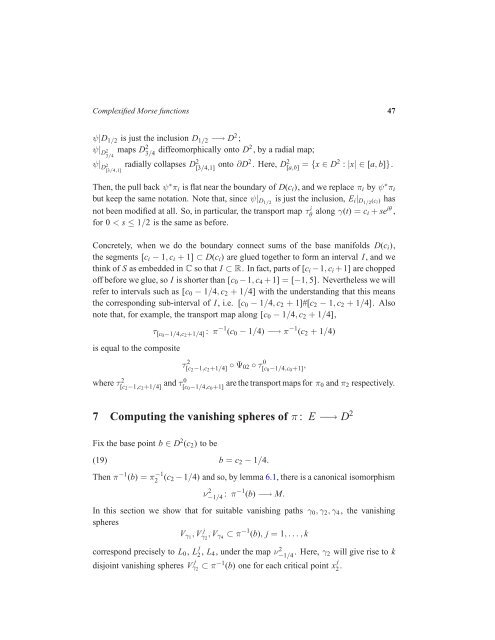The Picard-Lefschetz theory of complexified Morse functions 1 ...
The Picard-Lefschetz theory of complexified Morse functions 1 ...
The Picard-Lefschetz theory of complexified Morse functions 1 ...
You also want an ePaper? Increase the reach of your titles
YUMPU automatically turns print PDFs into web optimized ePapers that Google loves.
Complexified <strong>Morse</strong> <strong>functions</strong> 47<br />
ψ|D 1/2 is just the inclusion D 1/2 −→ D 2 ;<br />
ψ| D2 maps D<br />
3/4<br />
2 3/4 diffeomorphically onto D2 , by a radial map;<br />
ψ| D2 [3/4,1]<br />
radially collapses D 2 [3/4,1] onto ∂D2 . Here, D 2 [a,b] = {x ∈ D2 : |x| ∈ [a, b]}.<br />
<strong>The</strong>n, the pull back ψ ∗ πi is flat near the boundary <strong>of</strong> D(ci), and we replace πi by ψ ∗ πi<br />
but keep the same notation. Note that, since ψ|D 1/2 is just the inclusion, Ei|D 1/2(ci) has<br />
not been modified at all. So, in particular, the transport map τ i θ along γ(t) = ci + se iθ ,<br />
for 0 < s ≤ 1/2 is the same as before.<br />
Concretely, when we do the boundary connect sums <strong>of</strong> the base manifolds D(ci),<br />
the segments [ci − 1, ci + 1] ⊂ D(ci) are glued together to form an interval I, and we<br />
think <strong>of</strong> S as embedded in C so that I ⊂ R. In fact, parts <strong>of</strong> [ci −1, ci +1] are chopped<br />
<strong>of</strong>f before we glue, so I is shorter than [c0 −1, c4 +1] = [−1, 5]. Nevertheless we will<br />
refer to intervals such as [c0 − 1/4, c2 + 1/4] with the understanding that this means<br />
the corresponding sub-interval <strong>of</strong> I, i.e. [c0 − 1/4, c2 + 1]#[c2 − 1, c2 + 1/4]. Also<br />
note that, for example, the transport map along [c0 − 1/4, c2 + 1/4],<br />
is equal to the composite<br />
τ [c0−1/4,c2+1/4] : π −1 (c0 − 1/4) −→ π −1 (c2 + 1/4)<br />
τ 2 [c2−1,c2+1/4] ◦ Ψ02 ◦ τ 0 [c0−1/4,c0+1] ,<br />
where τ 2 [c2−1,c2+1/4] and τ 0 [c0−1/4,c0+1] are the transport maps for π0 and π2 respectively.<br />
7 Computing the vanishing spheres <strong>of</strong> π : E −→ D 2<br />
Fix the base point b ∈ D 2 (c2) to be<br />
(19)<br />
b = c2 − 1/4.<br />
<strong>The</strong>n π −1 (b) = π −1<br />
2 (c2 − 1/4) and so, by lemma 6.1, there is a canonical isomorphism<br />
ν 2 −1/4 : π−1 (b) −→ M.<br />
In this section we show that for suitable vanishing paths γ0,γ2,γ4, the vanishing<br />
spheres<br />
j<br />
Vγ1 , Vγ2 , Vγ4 ⊂ π−1 (b), j = 1,... , k<br />
correspond precisely to L0, L j<br />
2 , L4, under the map ν2 −1/4 . Here, γ2 will give rise to k<br />
disjoint vanishing spheres V j<br />
γ2 ⊂ π−1 (b) one for each critical point x j<br />
2 .
















